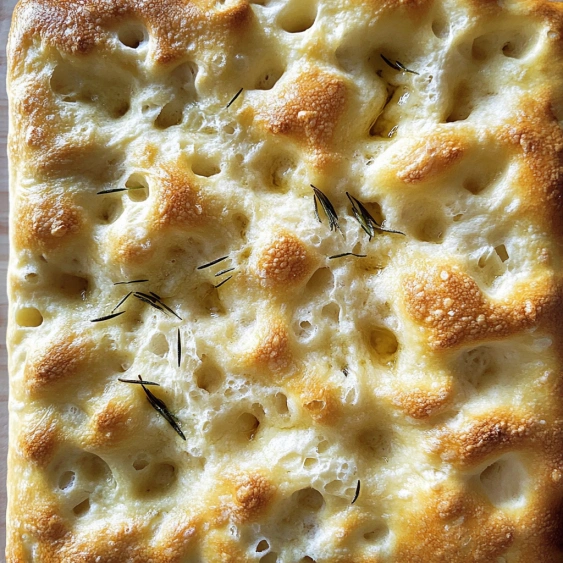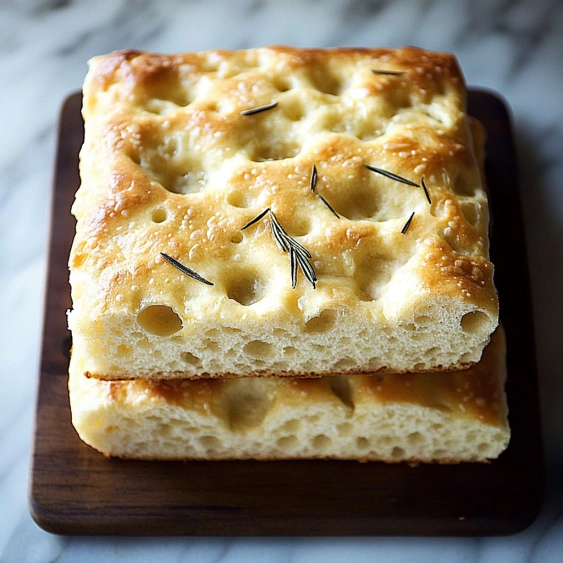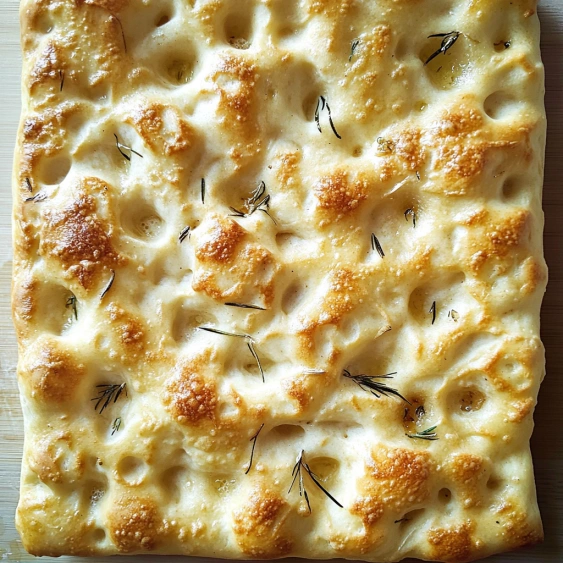 Pin it
Pin it
This homemade focaccia bread recipe transforms simple pantry ingredients into a bakery-quality Italian flatbread with crispy edges and a pillowy interior. The long, cold fermentation develops incredible flavor while requiring minimal hands-on work.
I first made this focaccia during lockdown when yeast was scarce and bread became a comfort food necessity. The moment my family tore into that first dimpled, salt-flecked loaf still warm from the oven, it became our Friday night tradition alongside a pot of soup.
Ingredients
- All purpose flour or bread flour: Creates the perfect structure. Bread flour will give a slightly chewier texture, but both work beautifully.
- Kosher salt: Essential for flavor throughout the dough. Diamond Crystal kosher salt is recommended for its clean taste.
- Instant yeast: Provides reliable rising with no proofing needed. If using active dry, see notes below.
- Lukewarm water: The specific temperature activates yeast without killing it. Mixing boiling and cold water ensures perfect temperature.
- Olive oil: Creates the signature crisp bottom crust and flavors the bread throughout. Use your best extra virgin olive oil here.
- Flaky sea salt: Adds crunchy texture and bursts of flavor on top. Maldon is the gold standard here.
- Rosemary leaves: Optional but traditional. Fresh rosemary adds aromatic flavor that complements the olive oil beautifully.
Step-by-Step Instructions
- Mix the dough:
- Combine flour, salt and instant yeast in a large bowl. Add lukewarm water and mix with a rubber spatula until completely incorporated. No kneading needed. The dough will be very wet and sticky. This high hydration is key to those beautiful air pockets. Coat with olive oil and cover.
- Cold fermentation:
- Place the covered bowl directly in the refrigerator for at least 12 hours or up to three days. This slow, cold rise develops complex flavor and gluten structure without effort. The longer the fermentation, the more developed the flavor becomes.
- Prepare baking pans:
- Line your baking vessels with parchment or grease thoroughly. Add olive oil to the pans. This creates the signature crispy bottom that makes focaccia so irresistible. Dividing the dough correctly ensures even baking.
- Shape and second rise:
- Use forks to deflate the dough and split it if making two loaves. Roll each portion in the oil to coat completely. Allow to rise at room temperature for 3-4 hours until puffy and doubled. The dough will slowly expand and fill the pans.
- Dimple and flavor:
- Press your oiled fingers straight down into the dough to create the characteristic dimples. These capture pools of olive oil and toppings. Add sea salt and optional rosemary. The dimpling prevents the dough from rising too much in the oven.
- Bake to golden perfection:
- Bake at 425°F for 25-30 minutes until deeply golden on the bottom and lightly golden on top. Cool briefly before slicing. The high temperature creates the perfect contrast between crisp exterior and tender interior.
 Pin it
Pin it
The first time I served this focaccia to my Italian neighbor, she became silent after her first bite. When she finally spoke, she said it reminded her of her grandmother's bread from a small town outside Naples. That moment confirmed I had found a recipe worth treasuring.
The Cold Rise Secret
The refrigerated fermentation is what sets this focaccia apart from quick versions. During this time, enzymes in the flour break down starches into sugars that feed the yeast, creating depth of flavor impossible to achieve in quick breads. The cold temperature slows yeast activity while allowing flavor development. This is why bakeries often use cold fermentation for their best breads.
Troubleshooting Tips
If your kitchen is particularly cold, your final rise may take longer than 4 hours. Look for visual cues the dough has doubled rather than sticking strictly to timing. For a faster version, you can use warm water and let the initial rise happen at room temperature for 1.5-2 hours until doubled, though flavor will be less complex.
When using active dry yeast instead of instant, dissolve it in the lukewarm water for 5-10 minutes until foamy before adding to the flour mixture. Use the same quantity but expect slightly longer rise times.
Creative Variations
Transform this basic focaccia by adding toppings before baking. Try thinly sliced tomatoes with fresh basil added after baking, caramelized onions and thyme, or roasted garlic cloves pressed into the dimples. For a sweeter version, skip the rosemary and top with grapes, figs and honey for a beautiful dessert focaccia.
 Pin it
Pin it
Frequently Asked Questions
- → Can I make this focaccia without the overnight rise?
Yes, though the overnight refrigeration develops better flavor and texture. For a quicker version, let the dough rise at room temperature for 2-3 hours until doubled, then proceed with shaping and the second rise.
- → What's the best flour to use for focaccia?
Both all-purpose flour and bread flour work well. Bread flour creates a slightly chewier texture with more gluten development, while all-purpose produces a more tender crumb.
- → Can I add other toppings besides rosemary?
Absolutely! Try thinly sliced onions, cherry tomatoes, olives, thinly sliced potatoes, or different herbs like thyme or sage. Add these before dimpling the dough and baking.
- → Why is my focaccia sticking to the pan?
Proper pan preparation is crucial. Use parchment paper and/or thoroughly grease the pan with butter or cooking spray in addition to the olive oil specified in the recipe. Glass baking dishes particularly benefit from butter to prevent sticking.
- → How do I store leftover focaccia?
Once completely cooled, store in an airtight container at room temperature for up to 3 days. For longer storage, freeze for up to 3 months. Always reheat at 350°F for about 15 minutes to revive the crust before serving.
- → Why do you dimple the focaccia dough?
Dimpling serves multiple purposes: it prevents the dough from rising too much during baking, creates pockets for olive oil to collect (adding flavor), and gives focaccia its characteristic appearance and texture.
